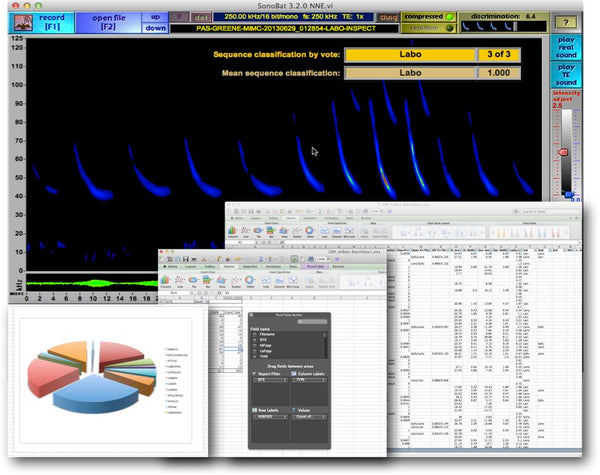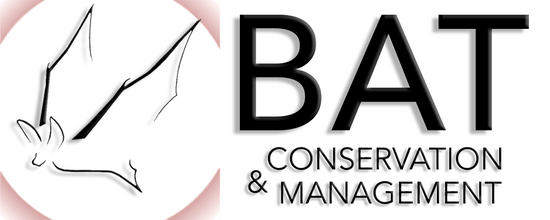Bat Acoustic Data Analysis

Surveys for bats are challenging. Today’s bat detectors have become so efficient, that it is easy to accumulate tens of thousands of files in a relatively short time. But, there is a steep learning curve just to get up-to-speed on the equipment and its best use(s), before collecting data.
Several automated software programs have been developed to handle large acoustic data sets. And, the software developers would lead us to believe that their products will make echolocation call analysis fast while providing highly confident results for species occupancy and bat activity levels. Unfortunately, the reality is that none of the current automated classifier tools associated with these programs are as accurate or precise as they need to be, especially when their outputs have the potential to impact major land management or development decisions.
The problem lies with the plasticity inherent in bat echolocation calls and how bats actually use echolocation. A bat’s need for information, and therefore the type of echolocation call it will produce, can change with prey-type, habitat complexity, and behavior. For many bat species, confident classification can only be achieved on a subset of call types within a bat’s repertoire. Currently, the only way to obtain high levels of confidence on species level identification is to have expert, human review of the recordings in question.
Because there have been no formal conclusions from any testing results to date on the accuracy of the four main analysis software programs being used in North America, land managers have been increasingly concerned over the validity of acoustic survey results and equipment. There is quite a bit of experience that goes into interpreting results from acoustic surveys. Projects attempting to place or dismiss T&E species solely on the basis of echolocation recordings can be challenging at best, it is important to be realistic about acoustic results, especially if that was the only survey method used on a project.
Not sure if you need a second opinion? We will be happy to provide new clients with our analysis of their selection of ~25 files. We will provide you with a full file-by-file description of the consensus between the classifier's output and our manual vetting for each recording you provide. Bat acoustic analysis is a very specialized field. Relying wholesale upon one reporting source for T&E species may leave consultants or managing agencies at great risk of legal liability.
What Services We Provide
1. A 2nd Opinion on already classified full-spectrum files. If your land management decisions costing up to millions of dollars hinges on relatively few audio recordings of bats, it makes sense to obtain additional expert opinions. Confidential and secure.
2. Auto-analysis with Manual Vetting on raw and/or attributed files for species of interest and/or the entire collection.
3. Complete Acoustic Survey Reports, summarizing data submitted, results of two (2) auto-classification outputs, MLE results and manual-vetting of species of interest.
What We Accept
Full-spectrum (FS) Recordings only (*.WAV format; *.WAC format will be accepted, at an additional charge).
Data must be submitted on an external storage device, no file-transfers will be accepted (use USB drives for small batches, external hard-drives for large batches). An exception to this may be if you only need a second opinion on a relatively small number of files(~500MB total .zip via filemail.com).
Large Batches of Data must be organized in separate folders by night and by detector.
Please Note: We Do Not Accept Zero-cross (Frequency Division) Recordings.
Additional Information Required for Each Data Batch Submitted
State and County where Recordings were made. Additional location information is helpful, but not required (e.g., nearest town, landownership, Lat/Long, elevation).
Date of deployment. Additional site information is helpful (e.g., weather conditions; temperature, dew point, cloud cover, humidity, wind, precipitation, etc.).
Make and Model of Detector used (include installed firmware version and all recording settings; inquire for a list of essential settings for your detector if you are unsure of what to include).
Microphone Type and Deployment description (e.g., external cabled microphone, any directional attachments, height above-ground-level (agl), and orientation/azimuth, position in habitat; over water, in clearing, along forest edge, etc.)
Who We Are
Janet Tyburec, received her initial instruction in the use of AnaBat detectors and AnaLook software in 1998 and spent the years since then becoming proficient in the detection, recording, and analysis of bat calls using a frequency-division (FD) system. In 2004 she began using the Pettersson time-expansion (TE) detectors with the SonoBat software system, deploying FD and TE units side-by-side for comparative studies on detection rates, sensitivity, and echolocation call comparisons, and is now using direct-recording detectors (DR) manufactured by all major manufacturers to expand these investigations. She was one of the beta-testers for the early versions of the SonoBat 3.0 automated species classification software for the developer, Joe Szewczak, and has used the final package to provide call analysis contract services for several federal and state agencies. During her annual training sessions, she deploys various configurations of both active and passive, FD, TE and DR, acoustic monitoring set-ups. She works in various field locations throughout the United States from the northeastern forests to the desert southwest, and regularly logs over 1,000 hours each season collecting voucher calls of known species, using detectors to actively monitor bats, and analyzing actively and passively collected calls with various software programs. She assists with instruction at acoustic monitoring workshops with developers Chris Corben and Joe Szewczak, and collaborates with colleagues who are power-users of the equipment and programs. This experience has provided her with an intimate familiarity of the acoustic repertoire of North American bat species, as well as with the signal processing capabilities of various detecting systems and nuances of automated species classification programs and filters.
John Chenger, President of Bat Conservation and Management, Inc. Carlisle, PA from 1999 to Present. Chenger created a company based on performing high quality bat sampling and management services for industrial, commercial and government clients. He designs, supervises and runs projects to meet USFWS section 7 and 10 Indiana bat consultation needs. He has sampled over 1,700 summer mist net sites and fall & spring mine surveys in 17 states across more than 125 projects. John designs bat acoustic monitoring studies and provides expert manual analysis of recordings. Also he is an expert in using SonoBat, Kaleidoscope, Echoclass, and BCID analysis software. Additionally, he has instructed or co-led over 48 training workshops for federal & state biologists, land managers, and consultants for proper use of all brands of acoustic monitoring equipment popular in the U.S. and bat capture techniques.
